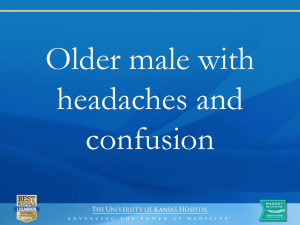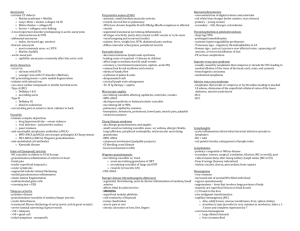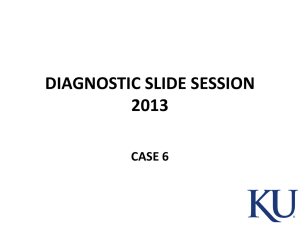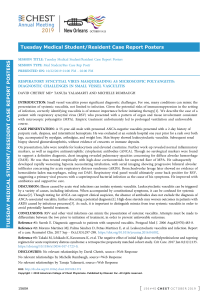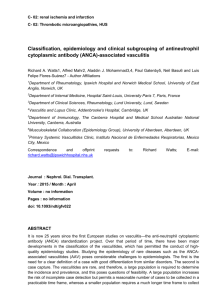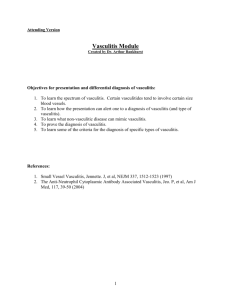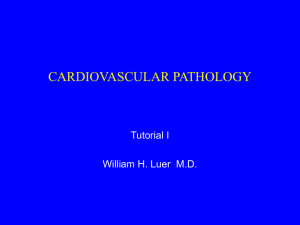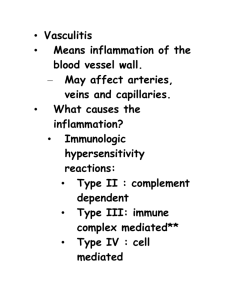Small Vessel Disease in the CNS Part II
advertisement
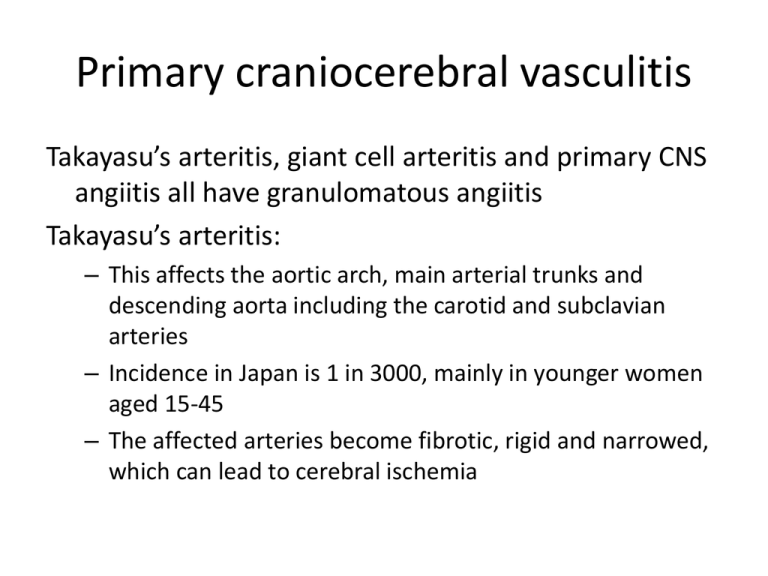
Primary craniocerebral vasculitis Takayasu’s arteritis, giant cell arteritis and primary CNS angiitis all have granulomatous angiitis Takayasu’s arteritis: – This affects the aortic arch, main arterial trunks and descending aorta including the carotid and subclavian arteries – Incidence in Japan is 1 in 3000, mainly in younger women aged 15-45 – The affected arteries become fibrotic, rigid and narrowed, which can lead to cerebral ischemia Giant cell arteritis Giant cell arteritis: – Most common of the three granulomatous arteritides (2 in 10,000 over age 50) – Targets the extracranial arteries of the head and neck – If the superficial temporal artery is affected it may be thickened and tender – There is an association with polymyalgia rheumatica, very elevated ESR and a risk of blindness from extension to the opthalmic arteries – It responds promptly to steroids – Can also affect the carotid and vertebral arteries leading to cerebral infarcts Primary CNS angiitis • Primary CNS angiitis: – Typically affects women aged 30-50 – Angiography shows narrowed segments in intracerebral arteries – Clinical picture is non-specific (eg headaches, confusion, memory impairment or focal deficits) – Aggressive immunosuppressive therapy can treat the disease effectively ABRA • Amyloid-beta related angiitis • An unusual complication of Aβ-CAA • 5 cases in the last 3 years ABRA • ABRA presents at an older age (mean 67) than primary CNS angiitis (mean 43), but younger than non inflammatory Aβ-CAA (mean 76) • Primary angiitis cannot be distinguished from ABRA except by pathology • Biopsies showing vasculitis should be routinely examined for Aβ deposits Vasculitis in systemic diseases • Lupus – 50-75% of patients have CNS involvement – Immune complex mediated vasculitis may lead to infarcts, vessels show fibrinoid necrosis, mononuclear inflammation and fibrosis – However, a predisposition to thrombosis is also advanced as the main cause of the CNS damage, and some authors discount vasculitis entirely • Polyarteritis nodosa – Causes necrotizing lesions in medium sized to small arteries – In systemic PAN the visceral organs are targeted – In limited PAN both skeletal muscle and peripheral nerve are involved with late CNS involvement Vasculitis in systemic diseases • ANCA associated vasculitides – ANCA stands for anti-neutrophil cytoplasmic antibodies – Wegener’s affects lung and kidney; about 30% develop CNS complications with focal necrotizing or granulomatous vasculitis – Churg-Strauss has an allergic component (with asthma and eosinophilia). There is a necrotizing vasculitis in medium sized to small arteries with extravascular granulomas and abundant eosinophils; 60-70% develop peripheral neuropathies or CNS involvement Vasculitis in systemic diseases • Sjögren’s syndrome – Autoimmune disorder that results in Sicca syndrome by involving the exocrine glands (salivary and lacrimal) – Involves peripheral nervous system with varying rates of CNS involvement – Vasculitis/vasculopathy has been described in venous vessels in CNS white matter and/or the leptomeninges • Behçet’s syndrome – Autoimmune disease producing recurrent oro-genital ulcers, uveitis and arthritis – 30-40% have CNS involvement typically meningoencephalitis of the brain stem (rhombencephalitis) – Vasculitis is reported in venules Vasculitis in systemic diseases • Rheumatoid arthritis – Vasculitis of the leptomeninges or parenchyma has been reported; this may respond to steroids • Hodgkin’s disease – Paraneoplastic vasculitis of the CNS is rare with the exception of Hodgkin’s disease • Drug induced – Vasculitis has been documented in users of cocaine and amphetamines. There is an association between hepatitis B and C and polyarteritis nodosa, which may link vasculitis to drug use Infectious causes • Bacterial – Both small and large arteries can be involved in pneumococcal meningitis and tuberculous meningitis, resulting in large infarcts • Spirochetes – Heubner’s arteritis occurs in meningovascular neurosyphilus; typically involves large extracranial arteries; T.pallidum cannot usually be identified in the vessel wall – Lyme disease due to B.burgdorferi which binds to vessel walls and induces vasculitis. Infectious causes • Viral – Herpes zoster infections in immunosuppressed patients can lead to necrotizing/granulomatous/lymphocytic cerebral vasculitis – Vasculitis also reported in HIV and after retroviral combination therapy • Fungal – Commonest infections due to aspergillus, candida, coccidiodes and mucor species An unusual case of CNS vasculitis • 50 year old female social worker • Past medical history of ulcerative colitis, benign essential hypertension and hypothyroidism • Colitis flared up 3-4 months before presentation, treated with prednisolone • Flared up 2 weeks before presentation again, treated with prednisolone Case history • Patient underwent investigative colonoscopy 1 day before presenting • Presented (Oct 2010) with continuous dull headache present during the work day • This had increased in severity by evening • Accompanied by slurred speech, unsteady gait and progressive right sided paralysis Case history • At a local hospital, she was diagnosed with a right sided stroke • While in hospital, developed sudden reduction in level of conciousness • ‘Grand mal seizure’ lasted 2 minutes • Patient was sedated, intubated and transferred to tertiary care hospital Gradient echo MRI scans CD3 CD68 LCA 173 involved vessels 88 in grey matter, 85 in white matter Mean diameter 66.7 ± 3.9µm Mean ratio of wall thickness to diameter is 0.18 ± 0.01 Vessels < 100µm are venules/veins or arterioles/small arteries But ratio is ca. 0.1 for venous vessels, ca. 0.5 for arterial, so most are venous Diagnosis • Acute vasculitis, mostly venous, in association with ulcerative colitis • Predominantly neutrophilic (acute) • Venous involvement explains the extensive hemorrhage since tissue is under arterial perfusion pressure Thanks! Questions?
